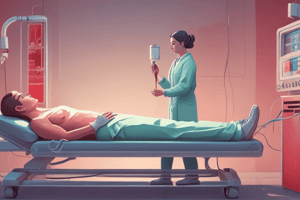Podcast
Questions and Answers
कितने समय तक आपको विश्राम करने के लिए प्रोत्साहित किया जाएगा पर्याप्त स्रावण या अन्य नॉन-एल्कोहोलिक तरल पीने के साथ?
कितने समय तक आपको विश्राम करने के लिए प्रोत्साहित किया जाएगा पर्याप्त स्रावण या अन्य नॉन-एल्कोहोलिक तरल पीने के साथ?
- 5-10 मिनट
- 15-20 मिनट (correct)
- 35-40 मिनट
- 25-30 मिनट
ब्लड डोनेशन के पश्चात स्क्रीनिंग क्या की जाती है?
ब्लड डोनेशन के पश्चात स्क्रीनिंग क्या की जाती है?
- रक्तदान की मात्रा की जाँच
- हृदय की जाँच
- लक्षणों की जाँच
- उच्च रक्तचाप की जाँच (correct)
रक्तदान से कैसे सम्बंधित खतरे हो सकते हैं?
रक्तदान से कैसे सम्बंधित खतरे हो सकते हैं?
- पेट दर्द हो सकता है
- संक्रामक बीमारियों का प्रसार हो सकता है (correct)
- सुखप्रदता हो सकती है
- हत्या हो सकती है
रक्तदान से संबंधित कौन सी सही बात है?
रक्तदान से संबंधित कौन सी सही बात है?
रक्तदान से कौन-सी महत्वपूर्ण प्रक्रिया में 3 हफ्ते का समय लग सकता है?
रक्तदान से कौन-सी महत्वपूर्ण प्रक्रिया में 3 हफ्ते का समय लग सकता है?
रक्तदान का पूरा प्रक्रिया (पंजीकरण से पोस्ट-डोनेशन स्क्रीनिंग) कुल कितना समय लेता है?
रक्तदान का पूरा प्रक्रिया (पंजीकरण से पोस्ट-डोनेशन स्क्रीनिंग) कुल कितना समय लेता है?
क्या किसी को रक्तदान के लिए पात्र होने के मामले में वयस्क होना एक महत्वपूर्ण मानदंड है?
क्या किसी को रक्तदान के लिए पात्र होने के मामले में वयस्क होना एक महत्वपूर्ण मानदंड है?
रक्तदान केंद्र में पहुंचते ही किसे पंजीकरण फॉर्म भरने के लिए कहा जाएगा?
रक्तदान केंद्र में पहुंचते ही किसे पंजीकरण फॉर्म भरने के लिए कहा जाएगा?
स्क्रीनिंग प्रक्रिया में पारित होने के बाद, किससे मिनी-फिजिकल परीक्षण कराया जाता है?
स्क्रीनिंग प्रक्रिया में पारित होने के बाद, किससे मिनी-फिजिकल परीक्षण कराया जाता है?
रक्त संग्रहाण के लिए स्क्रीनिंग प्रक्रिया में कौन-से मुख्य मुद्दों पर पूरा ध्यान दिया जाता है?
रक्त संग्रहाण के लिए स्क्रीनिंग प्रक्रिया में कौन-से मुख्य मुद्दों पर पूरा ध्यान दिया जाता है?
''रक्त-संग्रह' का प्रक्रिया में कौन-सा समर्थन होता है?
''रक्त-संग्रह' का प्रक्रिया में कौन-सा समर्थन होता है?
Study Notes
Blood Donation Process: Giving Life, Step by Step
The blood donation process is a simple yet profound act that saves lives. Here, we'll break down each step of this lifesaving process, helping you understand what to expect and how to prepare for your donation.
1. Eligibility and Pre-donation Screening
Before walking into a blood donation center, ensure that you meet the eligibility criteria. Generally, donors must be in good health, between the ages of 16 and 76, and weigh at least 110 pounds. Donors are also screened for their medical history and any potential infections.
2. Registration
Upon arrival, you'll be asked to fill out a registration form that includes basic information such as your name, address, and contact information. You'll also be asked about your medical history, which aids in the screening process.
3. Blood Donation Questionnaire
A licensed technician will take you to a private room to go over a more extensive questionnaire. The technician may ask about any recent illnesses, surgeries, or medications you're taking. They'll also check for any potential contraindications to blood donation.
4. Mini-physical Exam
In the private room, a trained professional will perform a brief physical examination, checking your blood pressure, pulse, and hemoglobin levels. They'll also examine your arms to ensure they're healthy enough to receive a needle.
5. Phlebotomy (Blood Collection)
If you've passed the screening process, you'll be shown to a reclined chair. A certified phlebotomist will clean your arm and insert a sterile needle into your vein to collect blood. The process can take up to 10 minutes.
6. Rest and Hydration
After blood donation, you'll be encouraged to rest for 10 to 15 minutes while you're monitored for any adverse reactions. Once you've passed the observation period, you can resume normal activities, but it's essential to stay hydrated by drinking plenty of water or other non-alcoholic fluids.
7. Post-Donation Screening and Snack
After donating, staff will check your blood pressure and pulse again to ensure you're doing well. You'll then be given a snack, such as cookies or juice, to help replace the fluids you've lost during the donation process.
8. Follow-up Screening
Your blood donation will be tested for transmissible diseases, such as HIV, hepatitis, and syphilis. These tests take about 3 weeks to complete, and you'll receive the results by mail.
Benefits of Blood Donation
- Enhances personal well-being: Donating blood can reduce your risk of heart disease and improve your overall health.
- Promotes self-discipline: Regular blood donation can help you develop better habits and maintain a healthier lifestyle.
- Strengthens your immune system: Blood donation stimulates the production of new blood cells.
- Saves lives: One blood donation can help up to three people in need of a transfusion.
Important Facts
- Blood donation takes about an hour, but the entire process, from registration to post-donation screening, usually takes about an hour and a half.
- Donors can give blood every 56 days.
- The need for blood donations is constant, with over 40,000 blood donations needed daily in the United States alone.
Blood donation is a safe, simple, and life-saving act that's open to almost everyone. By following these steps and understanding the process, you'll be empowered to give the gift of life to those in need.
Studying That Suits You
Use AI to generate personalized quizzes and flashcards to suit your learning preferences.
Description
यहां हम हर एक कदम को विस्तार से समझेंगे जो ब्लड डोनेशन प्रक्रिया में शामिल है, जिससे आप समझें कि आपका क्या अपेक्षित है और डोनेशन के लिए कैसे तैयारी करें।




